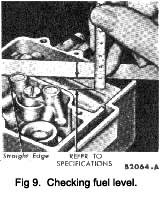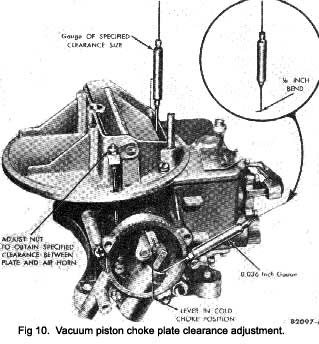ADJUSTMENTS
The fuel level float adjustment (dry) is performed only as a bench adjustment. It is correct when the outer end of the float top face is j-” (12.5 mm.) from the top face of the float chamber, when the float lever end is pushed down to seat the float needle. The choke clearance (pull-down) and fast idle cam linkage adjustments are usually performed with the carburettor on the bench however, they can be performed with the carburettor on the engine.
Fuel level float adjustment (wet)
The dry (bench) float level setting is a preliminary adjustment performed during carburettor overhaul procedures on the bench. This setting is used as a guide only; therefore, a final check and adjustment of the wet fuel level should be made as follows
1. Operate the engine for 30 minutes at 1200 r.p.m. to normalize engine temperatures, and place the car on a flat surface as near level as possible. Stop the engine.
2. Remove the air cleaner assembly, carburettor air horn assembly, and gasket.
|
3. Temporarily place the air horn gasket in position on the carburettor main body. Let the engine idle for several minutes, then remove the air horn gasket.
4. While the engine is idling, use a standard depth scale to measure the vertical distance from the top machi-ned surface of the carburettor main body to the level of the fuel in the fuel bowl (Fig. 9). The measurement must be made at least ~ in. away from any vertical surface to assure an accurate reading, because the surface of the fuel is concave (higher at the edges than at the centre). For the adjustment dimension see under carburettor, under Fuel System in the Data Section. Care must be exercised to measure the fuel level at the point of contact with the fuel.
5. If any adjustment is required, stop the engine to minimize the hazard of fire due to fuel spray when the float setting is disturbed. To adjust the fuel level, bend the float (contacting the fuel Inlet valve) upward in relation to the original position to raise the fuel level and downward to lower It. Each
|
 **
**

